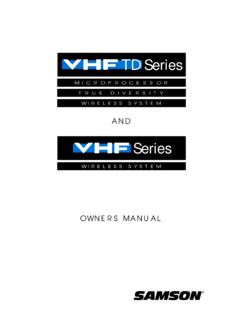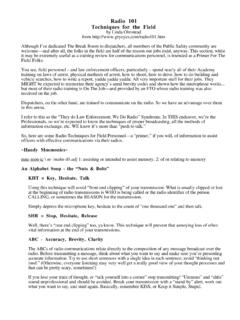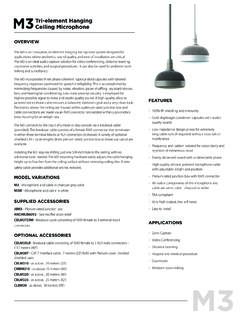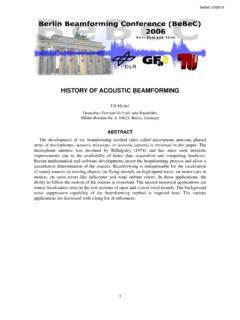Transcription of C02 ownman - SamsonTech
1 PROFESSIONALMICROPHONESC02 Condenser MicrophoneCopyright 2003, Samson Technologies February, 2003 Samson Technologies Underhill 9031 Syosset, NY 11791-9031 Phone: 1-800-3-SAMSON (1-800-372-6766)Fax: of ContentsIntroduction and Features3 Operating the C024C02 Applications5C02 Characteristics6 Wiring Guide7 Specifications7 Thank you for purchasing the Samson C02 Condenser microphone . The C02 con-denser microphone brings a high level of accuracy and audio performance toinstrument miking C02 is a pencil style condenser microphone that excels in both live perform-ance and recording applications. Equipped with a linear frequency response forsuperior reproduction, it is also designed to withstand high sound pressurelevels. Extremely sensitive, it employs a tight cardioid pattern to reduce special shock-mounted mic holder is included to minimize noise and provideadditional your microphone ever require servicing, a Return Authorization number(RA) must be obtained before shipping your unit to Samson.
2 Without this number,the unit will not be accepted. Please call Samson at 1-800-3 SAMSON (1-800-372-6766) for a Return Authorization number prior to shipping your unit. Please retainthe original packing materials and if possible return the unit in the original cartonand packing Samson C02 utilizes state-of-the-art microphone technology and isengineered to the finest detail. Here are some of its main features: Extended range frequency response for optimum reproduction andexceptionally clear, crisp sound with great transient response. Ultra sensitive, low mass element picks up all of the nuances of any perform-ance. Tight cardioid polar pattern minimizes feedback problems and effectivelyrejects signals not originating directly in front of the mic capsule. Withstands high SPLs, lending itself to a wide range of mikingsituations. Special shock-mounted mic holder is included to minimize noise and provideadditional protection.
3 Rugged brass case ensures reliable performance in even the most demand-ing environments. The included foam wind screen can be fitted to greatly reduce wind noisewhen used in an outdoor environment, or for reducing P Popping in vocalapplications. Lightweight and compact, the C02 can be mounted on any standardmicrophone stand using the included shock-mounted mic clip. Included foam-lined impact resistant carrying case for convenience when transporting three C02 microphones from venue to venue. Gold plated XLR and Features3 microphone Placement and Tone QualityListed are some common microphone placement techniques. Use these sugges-tions as a guide and let your ears determine what works best in your situation. Sound source less than 6 inches away from mic Full sound, pronouncedbass, increased isolation from background noise. Sound source 6 inches to 2 feet away from mic Balanced natural sound, lessbass, some background noise.
4 Sound source 3 to 6 feet away from mic Thinner ambient for microphone Use Aim the microphone at the desired source. Keep unwanted sound sources at a135 angle from the front of the microphone (see polar pattern). Place the microphone as close to the sound source as possible. Use the proximity effect to your advantage: The closer the mic is to the soundsource, the more emphasized the bass response will be. Use the windscreen to suppress unwanted wind noise. Never cup your hand over the microphone Notes The C02 will boost bass frequencies when the microphone is between 0 6inches from the sound source. As you move the sound source further awayfrom the microphone , the bass response will gradually roll off. The C02 has a built-in wind screen which protects against most wind andbreathing noise. Under adverse conditions, such as high winds, an optionalfoam windscreen can be used.
5 For maximum signal handling capability and minimal distortion, a minimumload impedance of 800 ohms should be used. A reduction in output signalstrength and output clipping level will result with the load at 150 the C024 Application NotesThe C02 is a great microphone choice for many instrument miking situations. Below is abrief guide on using the C02 in some typical GuitarThere are a variety of ways that the C02 can be used to mic an acoustic guitar. The micro-phone placement will depend on the type of instrument and what kind of sound you re look-ing to capture, for example the tonal quality you want to focus on, and how much fingerslide or pick noise you may or may not want. When miking a standard steel string acoustic,a good place to start is with the microphone positioned pointing towards the end of the fin-gerboard at a distance of about 6 inches to 2 feet away from the instrument.
6 You canexperiment by moving the microphone slightly in the direction of the sound hole, which willproduce more low frequencies, or move it in the direction of the fingerboard to capturemore high-end or to remove any unwanted boomieness. For nylon string acoustic try posi-tioning the microphone above the bridge to emphasize more of the attack from the soundof the finger picking, or for less, move the mic closer to the sound hole. If you have a pair ofC02 s, try one positioned at the fingerboard and the second over the sound can achieve outstanding results using the C02 on acoustic piano. Several placementapproaches can be used depending on the size of the piano, and the type of sound youare looking to record. When miking a Grand Piano for an ambient sound like that used in aclassical recital, a single C02 can be positioned directly in front of the instrument.
7 Open thelid to the full position and place the microphone five to twenty feet in front on the instru-ment. For a more contemporary ensemble sound, place two C02 s in the piano positioningone over the low strings and the other of the high Drum KitBecause of it s extended high frequency response and fast transient response the C02 per-forms outstandingly when used as an overhead cymbal microphone . You can position oneC02 on a boom mic stand directly above the kit pointing from front to back. For stereo mik-ing, use two C02 s placed over the drum set at a distance of three to five feet. You canexperiment with the exact placement depending on the size of the room and whether you relooking for an ambient or close-miked sound. In general, when miking a drum kit it s a goodidea to start with the overhead mics. Even though you use the overhead mics mostly for thecymbals, try to get the entire kit to sound great in the overheads.
8 Then it will be easier tojust bring up your individual mics for more attack and thickness in the overall HatThe C02 is a perfect microphone for miking Hi Hats thanks to its smooth top end and theability to capture fast attack transients. Try placing the microphone over the edge of the topcymbal. Experiment by moving the mic further over the cymbal to produce more of a sticksound, but keep in mind it may pick up more of the kit. Remember that the C02 has a car-dioid frequency response, so position the microphone in the direction of the Hi hat, but forincreased separation, be sure to point the mic away from other drums or cymbals Applications Notes56 The C02 can be mounted to any standard microphone stand (using the includedmic clip) or can be handheld. If handheld, take care not to cover the any part of thehead grille with your hand. Be aware of a phenomenon called the proximity effectwhich causes a noticeable increase in low frequencies (bass response) when amicrophone is close to the audio source.
9 This can have positive impact for exam-ple, it will cause your instrument or voice to sound much fuller when you sing closeto the mic than when you mic it at a distance. The key to developing the best mictechnique is experimentation, along with awareness of the general principle that,the closer your C02 is to a signal source, the greater the bass microphone has a characteristic polar pattern that determines how well itaccepts or rejects signal coming from various areas around the microphone . Forexample, omnidirectional mics accept all signals regardless of where those sig-nals originate (in front of the mic, behind it, to the side, etc.).In contrast, directional cardioid mics are specifically designed to accept mostlysignal coming from directly in front, and to reject signal coming from behind orfrom the side. The cardioid pattern is utilized by the C02 (as shown in the illustra-tion below).
10 For this reason, the C02 excels in environments where there is agood deal of unwanted ambient sound it delivers those signals originatingdirectly in front of the mic capsule itself while rejecting those that originate polar pattern also determines how prone a particular mic is to inducing feed-back. Feedback is that characteristic nasty howling sound that occurs when a micis placed too close to a loudspeaker the signal from the loudspeaker is fed intothe mic, then into the loudspeaker, then into the mic, over and over again until anoscillating tone is generated. Because the cardioid pattern utilized by the C02 isso good at rejecting signal not coming from directly in front of the mic, you ll findthat use of the C02 greatly minimizes feedback Polar PatternC02 Characteristics7 The C02 can be connected to any mixer, mixer/amplifier, or mic preamp using astandard microphone cable.
















